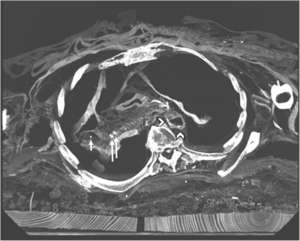Infectious Disease in the Neolithic
Introduction

By [Author Name]
At right is a sample image insertion. It works for any image uploaded anywhere to MicrobeWiki.
The insertion code consists of:
Double brackets: [[
Filename: PHIL_1181_lores.jpg
Thumbnail status: |thumb|
Pixel size: |300px|
Placement on page: |right|
Legend/credit: Magnified 20,000X, this colorized scanning electron micrograph (SEM) depicts a grouping of methicillin resistant Staphylococcus aureus (MRSA) bacteria. Photo credit: CDC. Every image requires a link to the source.
Closed double brackets: ]]
Other examples:
Bold
Italic
Subscript: H2O
Superscript: Fe3+
A citation code consists of a hyperlinked reference within "ref" begin and end codes.
Major Pathogens
Mycobacterium tuberculosis
Genetic evidence of Mycobacterium tuberculosis, the causative agent of tuberculosis, has been found as early as 5000 years ago [1]. It is most often identified as a Mycobacterium tuberculosis complex, a larger group that is recognized by standard DNA probes [2]The complex includes M. tuberculosis, M. bovis, M. africanum, and M. microti [2]. M. tuberculosis is one of the most common causes of tuberculosis, but M. bovis and M. africanum can result in similar symptoms in humans[2]. Of these, M. bovis mostly affects cattle but can infect humans if infected meat and dairy products are ingested, while M. africanum is responsible for the majority of tuberculosis cases in Africa [2]. M. microti specifically affects mice and voles[2].
Cases of tuberculosis are often recorded in Neolithic burials. It is among the diseases most commonly reported in the archaeological record because it leaves diagnostic changes on human bone, often in the form of lesions and spinal collapse (Figure 1)[1][3]. Calcifications in organs can also be indicative of previous tuberculosis infectionsCite error: Invalid <ref> tag; invalid names, e.g. too many. Others, however, suggest that the complex emerged during the Neolithic, and not before. Recently, DNA extracted from a Swedish mummy showing signs of tuberculosis contributed to a molecular clock phylogeny that placed a common ancestor to the M. tuberculosis complex as late as 2000-6000 years before present[4]. If this is the case, it would suggest that the emergence of human tuberculosis was correlated with the Neolithic revolution.
Regardless of its origin before or during the Neolithic, tuberculosis and its associated complex were likely more active once people began practicing agriculture. In a model aiming to characterize the maintenance of tuberculosis over time, researchers reinforced the claim that tuberculosis growth rates were higher in the Neolithic (0.1%/year) than they had been previously (0.003%/year)[5] . This trend may be tied to worsening living conditions that correspond with a shift to a sedentary lifestyle.
Section 2
Include some current research, with at least one figure showing data.
Section 3
Include some current research, with at least one figure showing data.
Section 4
Conclusion
References
- ↑ Jump up to: 1.0 1.1 Fuchs, Katharina, Christoph Rinne, Clara Drummer, Alexander Immel, Ben Krause-Kyora, and Almut Nebel. “Infectious Diseases and Neolithic Transformations: Evaluating Biological and Archaeological Proxies in the German Loess Zone between 5500 and 2500 BCE.” 2019. The Holocene 29 (10): 1545–57.
- ↑ Jump up to: 2.0 2.1 2.2 2.3 2.4 Rothschild, Bruce M., Larry D. Martin, Galit Lev, Helen Bercovier, Gila Kahila Bar‐Gal, Charles Greenblatt, Helen Donoghue, Mark Spigelman, and David Brittain. “Mycobacterium Tuberculosis Complex DNA from an Extinct Bison Dated 17,000 Years before the Present.” 2001. Clinical Infectious Diseases 33 (3): 305–11.
- ↑ Buikstra, J.E. ed. "Ortner's identification of pathological conditions in human skeletal remains." 2019.
- ↑ Cite error: Invalid
<ref>tag; no text was provided for refs namedSabin - ↑ Cardona, Pere-Joan, Martí Català, and Clara Prats. “The Origin and Maintenance of Tuberculosis Is Explained by the Induction of Smear-Negative Disease in the Paleolithic.” 2020. Pathogens 11 (3): 366
Authored for BIOL 238 Microbiology, taught by Joan Slonczewski,at Kenyon College,2024
